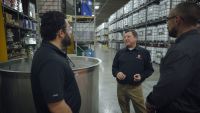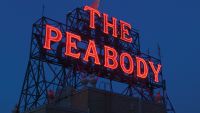We’re Golden!
MCAA's fifty years of serving the masonry industry
I am sure you would have been hard pressed to find mention in the New York Times, or any other paper nationwide, a notice of great significance to the masonry industry, but on August 27, 1950 the first convention of a new National Mason Contractors Association convened at the Grand Hotel, on Mackinac Island, Michigan. This newly formed alliance of mason contractors would continue on to effect how masony is constructed in the United States.
Fifty years ago the need for a national contractor organization was pressing - the Korean War brought many new governmental regulations, competition among mason contractors was severe, the training of craftsmen was lagging and promotion of the industry was insignificant. It was agreed that with all these issues and many more facing the industry, local masonry groups alone could not solve these matters. Mason contractors needed the full strength of a national organization to carry their voice.
The Chicago Mason Contractor Association took the lead in pulling together a series of formation meetings where organizational issues were discussed, including such matters as defining the term "mason contractor", representation, dues and a formalized name. One of the most important matters at hand was the development of an aggressive issues program, but it was very difficult since there were so many diverse opinions that had to be taken into consideration.
But before we get too far ahead of ourselves, let's go back and look at some of the significant meetings that made all of this possible.
On April 26 and May 26, 1950, a small group of mason contractors met in Chicago at the Morrison Hotel to map out plans for the national organization. Using the experiences of an early 1900's organization called, the Mason Contractors Association of the United States and Canada, the group tried to avoid the pitfalls that ultimately led to its demise.
Several months later, on July 14, 1950, a final organizational meeting was held in Chicago to hammer out a final draft of the Constitution & By-Laws and to develop a dues structure that made parties comfortable. The next steps were to finalize a nine point program that adequately presented the position of the nation's mason contractors and to plan the first national convention of the new organization.
On August 27, 1950, twenty-one delegates from nine geographic areas arrived at the Grand Hotel on Mackinac Island, Michigan for the inaugural convention. The participants met on August 28 to elect officers and to formally create the Mason Contractors Association of America. Interesting enough, the first election for President resulted in a deadlock. On the second ballot, Marshall Harrison was declared the winner.
Marshall Harrison of Kansas City, Missouri was elected the first President with Norman Bouchard of Oak Park, Illinois as Vice President. Robert Fulcher of Nashville, Tennessee and Harry Cohen of Chicago, Illinois were chosen as Secretary and Treasurer, respectively.
During the afternoon session, administrative matters were discussed. Members agreed that "Association" would be incorporated in the "State of Illinois" and the voting power of each chapter would be one vote for each 10 members, with stipulation that all members of a chapter were affiliated. Mandatory affiliation was a major issue since it was one of the main reasons why the old national mason contractors organization failed. Next item on the agenda was a discussion of finances and dues, which were established at $10 per year per member with a limit of $500 for any organized chapter.
On August 29th, temporary Chairman, Carl Yantz of Louisville, Kentucky turned the gavel over to President-elect Marshall Harrison. The delegates then turned to the task of agreeing on a workable Constitution and By-Laws. They adopted a Preamble and Objects and Purposes, that are still in effect today with only a minor alteration.
After tedious discussions on membership requirements, at 10:40 a.m., William Picco of Washington, D.C. moved that the Constitution & By-laws be approved. This motion was seconded by Bob Fulcher of Nashville, Tennessee and was unanimously approved. The new organization was now officially in business.
During the past fifty years MCAA has had many major accomplishments that not only helped the masonry industry but the entire construction industry as well. From expanding the use of masonry, to protecting the rights of mason contractors, the MCAA has been involved in contractor issues. In the late sixties a Texas Court ruled that contractors were not parties to a jurisdictional dispute. The case was taken to the Supreme Court. Seeing the danger in this matter, the MCAA formed a collation of subcontractor groups to fight this decision. The Supreme Court eventually overturned the lower court decision, consequently saving MCAA members a tremendous amount of money by allowing them to defend their work assignments on forklifts, scaffolding and other masonry equipment.
A great deal of change has occurred in how masonry is constructed in the United States. Starting this evolution was MCAA's Material Handling Committee, which served as a catalyst for a more efficient and productive masonry operation. This committee created the motivation for the masonry industry to develop packaging and handling equipment to meet the need of the mason contractor and productivity on the job site.
Weather has always been a big factor in masonry construction as it dictates the work schedule. The All-Weather Committee, headed by the MCAA, produced a nationally recognized industry standard for both hot and cold weather masonry construction.
MCAA's participation in the Construction Industry Stabilization Committee, created by President Nixon during the early seventies, was a true recognition of MCAA's stature. The MCAA was actively involved as this program stabilized the wage structure for construction workers in a very unsettled period.
The Association's Management Institute was an unprecedented program that has provided MCAA members with the opportunity to advance their skills in financial planning, contract development, management, estimating and computer skills. The estimating seminars alone have been attended by over 3,200 members, with new courses being developed for presentation.
Apprentice training, promotion and a bricklayers nation-wide pension fund have also been leading programs shepherded by the MCAA. Our efforts to tackle the very sensitive wall-bracing issue and to develop a recommended practice was exemplory of our strong leadership abilities.
MCAA's most significant accomplishment has been to serve as a catalyst to bridge the gap between special industry interests. The association has successfully unified these groups into a strong working team that has been able to solve many of the industry problems.
MCAA as an international trade association, has provided the nation's mason contractors with a vehicle to secure and obtain objectives that might not have been possible as individuals. Through cooperative efforts, they have made tremendous progress and will continue to do so in the future.
It's been a long journey - exciting and wonderful. The fifty years have been spiced with victories and defeats, but the primary objectives and purposes of the association have never been compromised. The MCAA membership is loyal, dedicated and comprised of unselfish individuals who serve their industry. From the initial meetings in Chicago and Mackinac Island, until the most recent ones in Las Vegas, members have always given of their time generously. In the process, they've become a community working together for a common cause and a single goal - one to make the industry a better and stronger place for all.
About the Author
George Miller was the Executive Vice President Emeritus for the Mason Contractors Association of America.


















